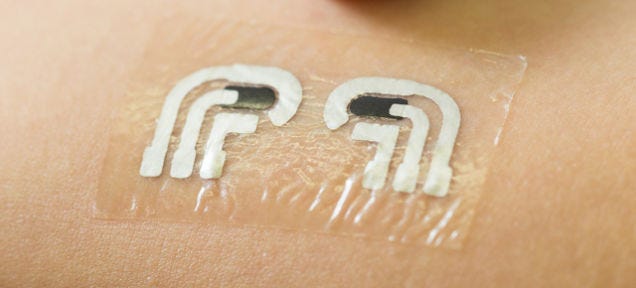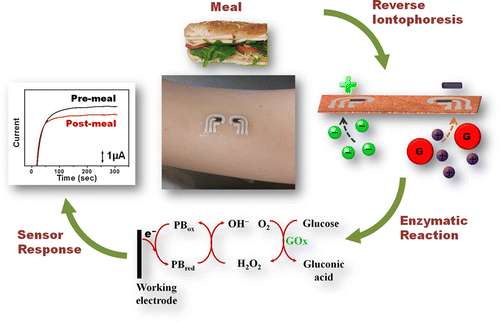A Tattoo That Does Away with Finger Pricking for Diabetics
January 15, 2015
As any diabetic knows, pricking your finger repeatedly for a blood-glucose test is not exactly a fun ordeal. Thankfully, researchers are working on an alternative method that will be completely painless and needle-free, a rub-on temporary tattoo.
The ultrathin, flexible device was created by Joseph Wang and his colleagues at the University of California, San Diego in an effort to develop a sensor that could effectively measure glucose levels with the same efficiency as finger-pricking, according to a paper published by the American Chemical Society.
|
This temporary tattoo could monitor glucose, potentially giving diabetics a painless alternative to finger pricking. |
The genesis of the idea was born out of the GlucoWatch, a wristband that was developed to gently suck glucose through the surface of the skin, but was eventually discontinued because the electric current that was used to attract glucose to the surface of the skin was too high, and was reportedly uncomfortable. (The idea of a tattoo-based technology to monitor glucose was also explored in 2009 by researchers at Draper Laboratory, in Cambridge, MA. ) Researchers designed this tattoo using a gentler current that is still just as effective.
The electric current detects glucose through an enzyme that breaks glucose down into oxygen and hydrogen peroxide. The amount of hydrogen peroxide serves as a proxy for blood-glucose levels. Researchers hope this method could serve as a permanent alternative to the painful method of finger pricking, a technique that can discourage people from keeping tabs on their glucose levels regularly.
From the abstract:
We present a proof-of-concept demonstration of an all-printed temporary tattoo-based glucose sensor for noninvasive glycemic monitoring. The sensor represents the first example of an easy-to-wear flexible tattoo-based epidermal diagnostic device combining reverse iontophoretic extraction of interstitial glucose and an enzyme-based amperometric biosensor. In-vitro studies reveal the tattoo sensor's linear response toward physiologically relevant glucose levels with negligible interferences from common coexisting electroactive species. The iontophoretic-biosensing tattoo platform is reduced to practice by applying the device on human subjects and monitoring variations in glycemic levels due to food consumption. Correlation of the sensor response with that of a commercial glucose meter underscores the promise of the tattoo sensor to detect glucose levels in a noninvasive fashion. Control on-body experiments demonstrate the importance of the reverse iontophoresis operation and validate the sensor specificity. This preliminary investigation indicates that the tattoo-based iontophoresis-sensor platform holds considerable promise for efficient diabetes management and can be extended toward noninvasive monitoring of other physiologically relevant analytes present in the interstitial fluid.
The research is part of an extensive effort aimed at developing noninvasive glucose sensors that rely on optical, ultrasound, spectroscopic, heat, and electrochemical techniques. Among all all of these, the electrochemical techniques--like this rub-on tattoo--have shown the greatest promise.
|
The temporary tattoo is but one example of a number of alternative glucose measuring methods that have popped up in recent years. |
Alternative glucose measuring methods have been have been popping up in various forms over the last several years, as many recognize the intrusive and taxing nature of finger pricking. Consider the Google and Novartis glucose-sensitive contact lenses. Just last year researchers at Princeton University developed a laser that can measure glucose levels when directed at a person's palm. They're currently working on scaling down the size of the laser in the hopes of creating a handheld device that is simple and easy to use.
Now that Joseph Wang was able to find an alternative method to the GlucoWatch that is wearable and less irritating, the trick was ensuring it could detect glucose levels efficiently. The platform works by detecting the glucose in the fluid just under the skin, based on integrating glucose extraction and electrochemical biosensing. Preliminary test results conducted on seven healthy volunteers showed it was able to accurately determine glucose levels, making the tattoo one of the first of its kind to achieve successful results in human trials.
While a few challenges still remain, such as establishing a reliable electronic backbone for powering the sensor, the initial proof-of-concept demonstrations have provided encouraging results that researchers hope to build upon as they look to create a sustainable glucose monitoring alternative. If successful, it may not be long before we see diabetics rocking ink in a whole new and exciting way.
Refresh your medical device industry knowledge at MD&M West, in Anaheim, CA, February 10-12, 2015. |
Kristopher Sturgis is a contributor to Qmed and MPMN.
Like what you're reading? Subscribe to our daily e-newsletter.
About the Author(s)
You May Also Like



.png?width=300&auto=webp&quality=80&disable=upscale)
